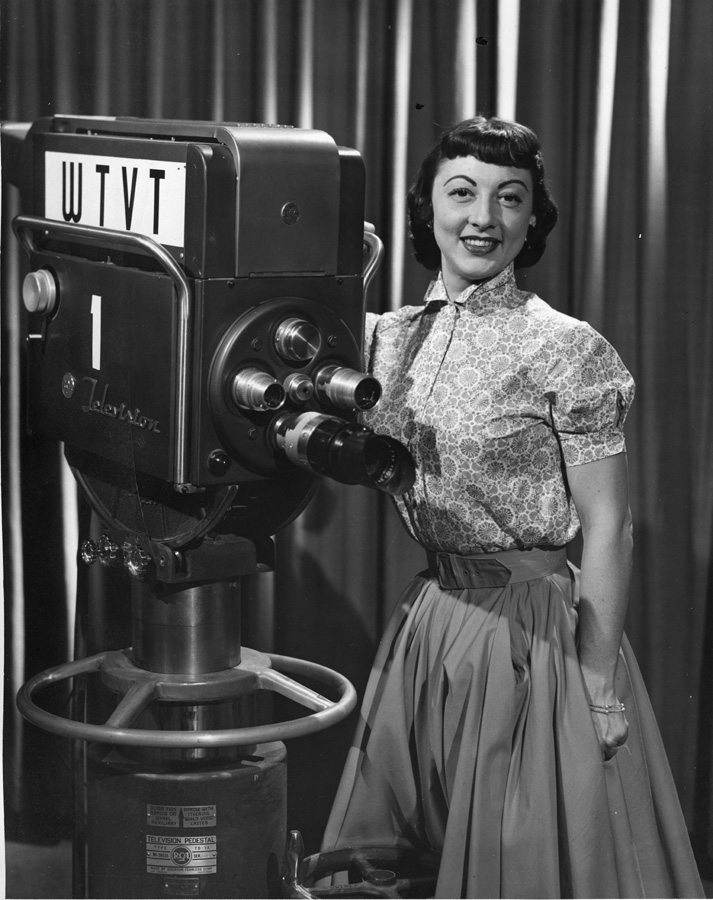
An RCA TK-11A with Channel 13's Lynn Stuart Horner
WTVT Cameras

An RCA TK-11A with Channel 13's Lynn Stuart Horner
RCA and General Electric were primary suppliers of television studio equipment when WTVT began operations in 1955. Since the NBC network was owned by RCA, network operations and NBC affiliates favored equipment manufactured by RCA. RCA/NBC's competitor CBS grudgingly used RCA cameras. In an effort to reduce the RCA branding, CBS removed RCA insignias and repainted the cameras gray with the CBS eye prominently displayed. Channel 13's chief engineer Daniel H. Smith opted to start operations with two RCA-TK11A cameras, and two TK-31A field versions in their remote truck.
In Channel 13's single studio, Camera 1 was mounted on a standard Houston Fearless pedestal. The H/F pedestal was a rather heavy, clunky device, but it did allow the operator to steer and dolly in a professional manner. Increasing or decreasing the height was accomplished by rotating a circular wheel attached to the base of the pedestal. It was practically impossible to do this smoothly while on the air.
The camera was equipped with four fixed-focal length lenses mounted on a turret. The lenses ranged from wide angle to telephoto. Changing lenses required the operator to remove his hand from the starboard focus control (seen in photo above) then grip and turn a handle connected to the lens turret beneath the viewfinder. As the handle rotates the turret the camera's image is blanked out as one lens passes out of view and another racks into place. Then, the operator must re-focus. Often, the camera would end up on-air during the rotation.
Camera 2 was mounted on a tripod, preventing any on-air changes in height. Tripods are normally used in field operations but it's possible that Channel 13 did not want to invest in the cost of two pedestals. Camera 2 had a Zoomar lens, which was a primitive version of our modern-day zoom lens. Compared to the focal lengths of Camera 1's lenses, the Zoomar could not provide extreme wide angle or telephoto shots. Zoom lenses of the period tended to be medium-wide and medium-telephoto, with a 4- to-1 zoom range. The advantage was that the shot could be changed smoothly from wide angle to telephoto (or reverse) without racking a turret.*
These mid-50's style cameras used image orthicon tubes to create NTSC television pictures. The I.O. tube (AKA 'orth') was a workhorse of the broadcast industry for twenty years but early versions suffered from image retention. If you left the camera aimed at static image for too long it would 'burn in' to the I.O. tube. The image would be retained for a moment once the camera was repositioned. Production manager Dan Boger recalled the use of 'orbiters' to prevent the burn in. Apparently, the orbiter was a mechanical device placed on the lens turret that moved the image in a subtle manner and thus prevented a burn-in. The RCA cameras typically required about 150 foot candles to produce an acceptable picture.

This rare color slide from 1959 shows the crew preparing for Roy
Leep's weather segment.
|
A different kind of camera was used to convert 16mm film and slides into a television signal. Referred to as a film chain, the unit consisted of a 16mm film projector aimed at a camera through a system of mirrors. 35mm slides could also be used for station I.D.s or commercial announcements. Switching between the 16mm film and 35mm slides was accomplished through the use of mirrors controlled from the master control panel. Unlike the studio cameras, the film chain camera did not use image orthicon tubes. Vidicon tubes, invented in the early 50's, were used instead of orthicons because of their lower cost, longer life and stability. The vidicons required much more light then the orthicons but were less prone to 'burn in' when slides were left exposed for lengths of time. Channel 13's original film chain was capable of color but rarely used for that purpose due to a lack of color programming. (RIGHT) An RCA TK-26 color film chain
|
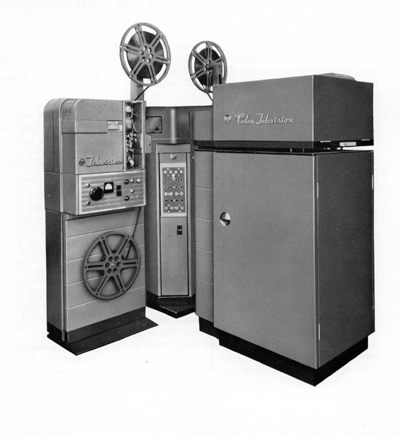 |
Color came to Channel 13 in June, 1966. The delivery of four RCA TK-42 color cameras began a new era of local, live color.
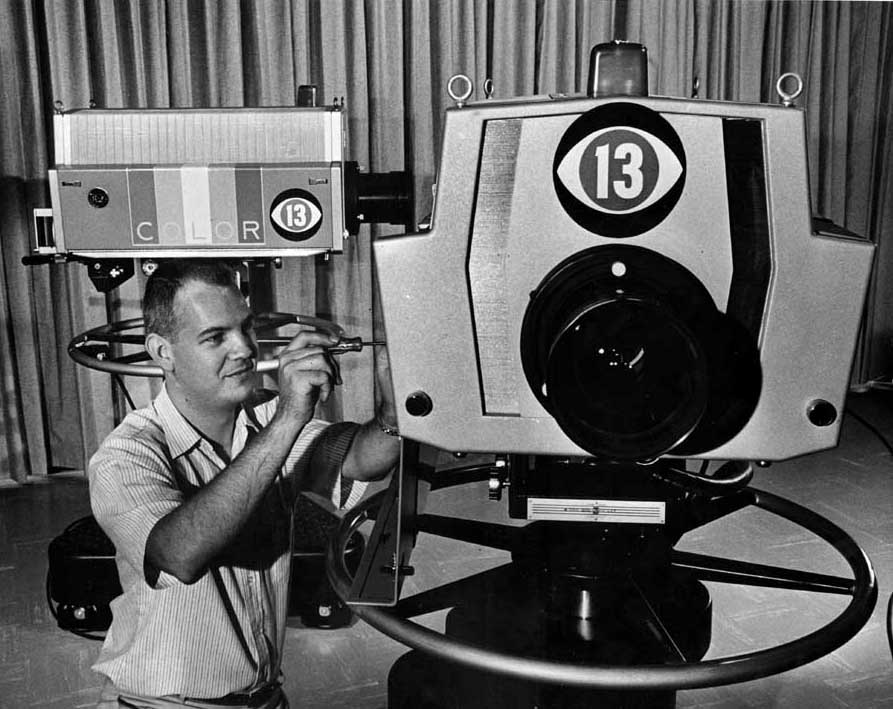
Engineer Adrian Snow adjusts the RCA-TK 42. Note built-in zoom lens.
Channel 13 engineer Adrian Snow, who had attended a TK-42 technical seminar at RCA, lead the other WTVT engineers through several weeks of new color camera training. The TK-42 was an entirely new design, combining three vidicon tubes (red, blue, and green) with an image orthicon (monochrome channel). Lighter in weight and more transistorized than its TK-41 predecessor, the new TK-42 came with a built in 5 to 1 zoom lens (the TK-43 was equipped with an external 10 X 1 zoom).
Inside a TK-42...3 vidicons and 1 image orthicon.
Note rear
zoom control (left handle) and focus control (right handle)
The camera would fit onto the standard Houston Fearless electric pedestals but a new, larger control ring was needed for steering. The TK-42 required almost twice as much light as the older black and white models. 250 foot candles was the norm and in some situations even more lighting was required. It was also apparent from the start that the Vidicon tubes in the TK-42 produced a somewhat plastic color picture when compared with the images produced by the Plumbicon-tubed Norelco PC-60.
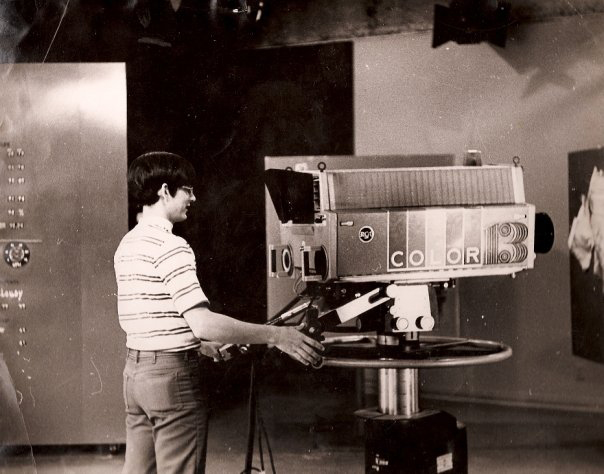
Gil Muro operates a TK-42 with standard zoom and focus control modification.
Note the dual zoom/focus controls rendered inoperable.
The TK-42 zoom and focus controls were modified early on when the crew realized the original rear-control design was not practical. The zoom and focus were run via cables to conventional controls on the starboard and port pan handles. This solved the operator's access problems, but affected the zoom mechanism's movement. The cables had a tendency to crimp and this would cause the zoom mechanism to stick, or 'chatter.'
Channel 13 also ordered an additional color film chain and color video tape recording equipment to make the conversion to color complete.
|
|
|
By 1970, the RCA TK-42s had been in use for five years. Engineers were fed up with the TK-42's high maintenance issues and camera operators were frustrated by the chattering zoom lenses. New cameras from RCA, G.E. and Norelco gave WTVT a better choice for the next generation of live color. General Electric had the advantage of reliable use at WTVT since 1968, when Chief Engineer Lawton Metcalf installed G.E. PE-350 color cameras on the WTVT color mobile unit. The G.E. cameras used Plumbicon tubes such as those in the Norelco PC-60 and PC-70 which were superior in detail and color rendition. Because of the favorable performance of the G.E. color cameras on the their mobile unit, Melcalf chose to replace the TK-42s with General Electric PE-400s which used 4 Plumbicons; three dedicated to the color signals and one for monochrome. Four G.E. PE-400 cameras arrived during December of 1970 and after several weeks of setup and training with the engineering department, the new cameras made their on-air premiere in January of 1971. The Tk-42s were donated to WEDU-TV, the local PBS affiliate.
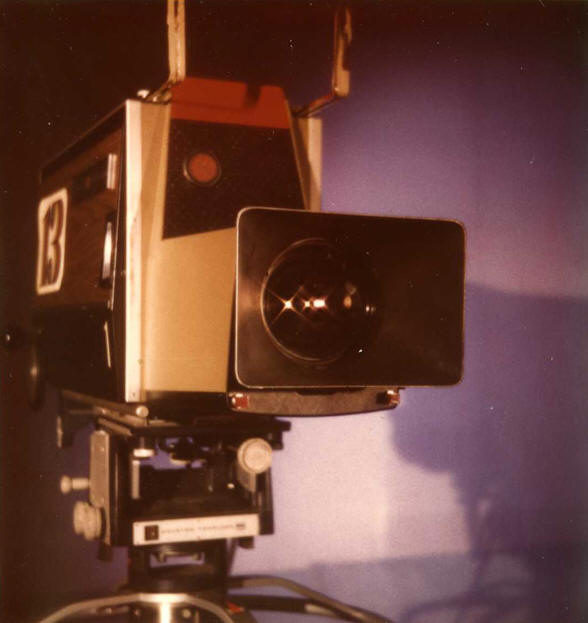
G.E. PE-400 color camera
Richard Bozeman operates a G.E. PE-400 during 1972 election
coverage.
Although large and heavy like the TK-42s, the PE-400s had a very smooth zoom lens because the zoom control on the camera's starboard side was linked directly to the lens with no cabling to cause lens 'chatter'. New Houston Fearless counterweight pedestals were ordered for use with PE-400s providing a smooth way to increase or decrease camera height. The only disadvantage is that the weight of the camera and pedestal was approaching 500 pounds. This meant that the camera required a good shove to move across the studio floor.
Todd DeBonis with a Norelco PC-70
Channel 13's color mobile unit was originally equipped with G.E. PE-350. At the request of network clients, four Norelco PC-70s were installed in 1971 and used successfully until 1978 when they were replaced by Philips LDK-25s.
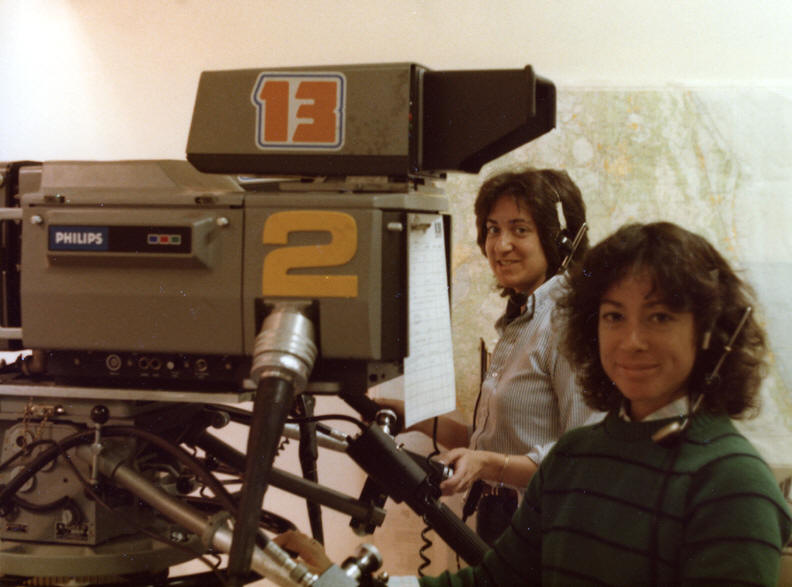
The studio's PE-400's were replaced in 1980 by the mobile unit's LDK-25s, which were then equipped with Teleprompters.
*A Zoomar lens is operated from the rear of the camera using a slim metal dowel. Pull back on the dowel, and the camera 'zooms' in. Push in on dowel, and the camera 'zooms' out to a wider angle. Focusing was accomplished by a disk attached to the cameraman's end of dowel. Twisting the disk left or right would focus the lens when it was in the telephoto position.